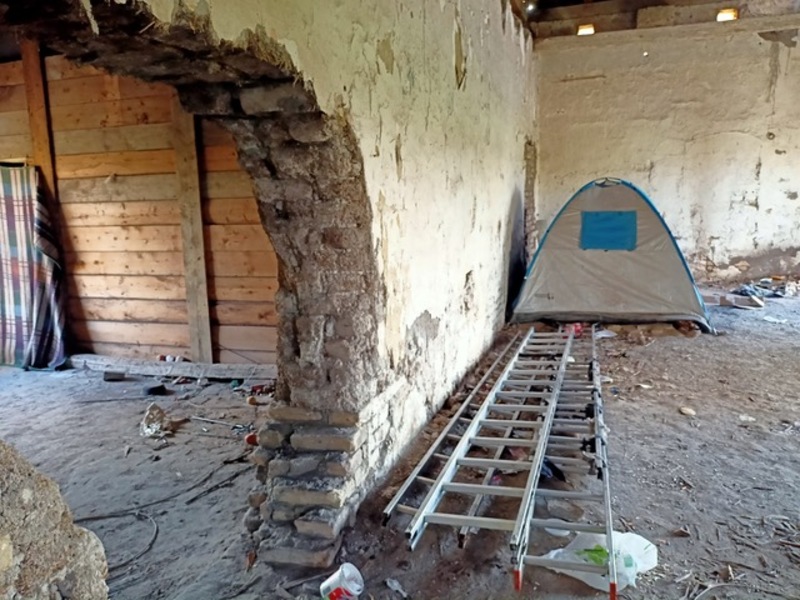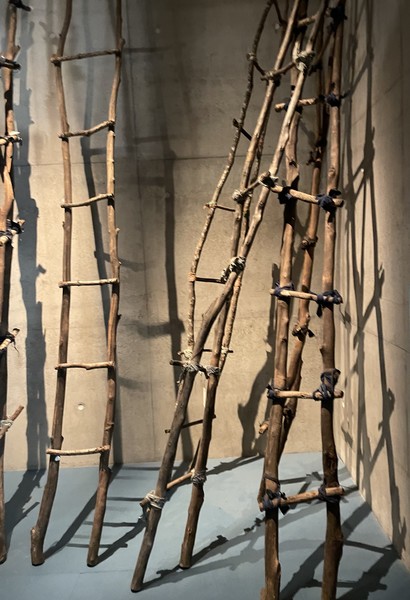Ladders
Ladders are objects used in attempts to climb over fences, walls, wire, or other physical barriers at borders. In the context of illegalized migration, ladders symbolize resourcefulness, resilience, and the necessity of exposing oneself to risk. These objects are used at various borders around the world, including borders with high physical barriers along the Balkan route, such as the one between Serbia and Hungary.
Seemingly trivial, objects have the power to influence human experience. Materiality is a lens through which we can observe relationships, both social and those that people establish with objects (Miller 2005). The concept of ladders is often used as a metaphor for class mobility. A ladder made of aluminum or wood can be used to change a light bulb in an apartment, paint a wall, reach something at a height, or perform any handyman job. It can also be used to climb over a border fence intended to prevent entry into a territory.
Ordinary, everyday objects, such as ladders, acquire different meanings and purposes when encountered at borders. These “trivial” objects—which at first glance have nothing to do with borders and migration—can construct and deconstruct borders, make them stronger or weaker, and create alternative, often non-verbal knowledge (Tuulikki 2020). Researching the role of these objects helps us understand the physical act of crossing a border. For instance, Jason De León (2013) studied objects left behind in the desert along the Mexico-US border, revealing much about how suffering has become normalized in the process of crossing on foot. The experience of using ladders is physical, tangible, risky, and non-verbal.
I observed ladders used as tools for border crossing, or as part of game equipment, piled up during a visit to a camp in Sombor in 2021. Ladders are traded there. People labeled as “smugglers” – who may also be workers trying to pay for their own journey – sell ladders to their companions at prices several times higher than those in official stores, and they set them up on fences. The ladders used for the game at the Serbian-Hungarian border are extendable fire ladders. They can be seen in a photograph taken by the NGO Klikaktiv in a squat:

Horgoš, 2021. Photo: Klikaktiv
At the end of a music video in Arabic, filmed at the Serbian-Hungarian border, there is a scene depicting the crossing of the border using ladders, followed by police cars chasing the trespassers. In Serbian media, this video was described as an advertisement for a prominent smuggler. The title of the video, or the trap song, is حارق (pronounced /hāreq/), a term connected to حراقة (pronounced /harāqa/), which has become a metaphor for illegalized migration as the activity of “burning borders” (M'charek 2020). The content of the video and the song's lyrics imply that ladders are one of the tools used to “burn” the EU's fortified borders, with the smugglers being the ones who hold the matches.
Ladders are potentially dangerous objects even in a household. They are always approached with caution. In the context of illegalized border crossings, the danger is significantly greater, as evidenced by a Klikaktiv post from 21st January 2021.
FROM THE FIELD
While working with refugees, we noticed that some of the most common injuries they encounter when trying to cross borders are leg injuries. These injuries happen to them while jumping the fence - when they are in a hurry, they are in fear or they are being chased by the police, so they do not have enough time to go down the fence more or less carefully.
However, there is another reason why fractures and sprains of the legs, feet and ankles are so common. To make the whole story more understandable, we give you a brief insight into what a part of the border crossing between Serbia and Hungary looks like. In front of the fence itself, there is a barbed wire on the ground through which the refugees break through crawling, covered with blankets or sleeping bags, so that the wire would not cut them. After being dragged through the several meters long barbed wire trap as soldiers in the movies, two fences await them. Both are about four meters high and are also wrapped in layers of barbed wire at the top. The distance between the two fences - the patrol zone - is so large that only two police jeeps can pass in the passage. In order to cross those two fences, people pay the smugglers large amounts of money so that they can set the ladder for them to cross one and the other fence at the right time. Many people from the refugee population set out on a journey with a very limited amount of money and very often do not have the money to pay for crossing the entire fence or are saving money for the further journey. In that case, they decide to pay money to cross the first fence and to climb to the top of the second fence, from which they will then jump in the hope that they will be able to land on the ground without major injuries. There are whole groups of people who get ladders for climbing and descending from the first fence from the smugglers, while only one ladder for climbing is set for the second fence, and there is no ladder for descending, because they are not paid. Then there is a jump awaiting for all of them. This causes severe injuries that will follow most people throughout their lives, because they are usually not treated in time and, above all, not treated well enough medically.
Climbing up ladders, descending down ladders, and jumping from fences when there are no ladders—these are body techniques at the border. The body techniques that migrants learn en route are unique to the context of illegalized border crossings. They are shaped by a complex network that includes border enforcement practices, the environment, migrant material culture, smugglers and other factors (De León 2013: 329). Ladders serve as an element of the subversive activity of “burning borders” and are also an element of violence at the borders. Serious physical injuries can occur if the risks and body techniques of using ladders are not mastered.
In 2022, it was mentioned that Hungary would extend the fence on the border with Serbia by one meter. The Klikaktiv team recorded a comment on this topic from a young man from Morocco in a post from 12th August 2022:
If they extend the fence by one meter, we will extend the ladders by one meter, too.
This highlighted quote points to the ongoing cat-and-mouse game between people on the move and border authorities. It is a form of struggle interpreted through the lens of autonomy of migration. Ladders could be understood as a type of mobile commons that people create and use in migration despite efforts by authorities to stop them, but also as “commodities” traded among them.
Wooden ladders are often used at the border between Mexico and the USA. Several long wooden ladders used for crossing the border from Africa into European territory (Ceuta and Melilla) were collected and displayed at the Museum of World Culture (Gothenburg, Sweden). These ladders served as inspiration for this text.
Ladders materialize the idea that fences cannot stop migration; they only foster creativity, increase crossing costs, and intensify the risks for those forced to climb over them.


13/9/2023
Literature
De León, Jason. 2013. „Undocumented Migration, Use Wear, and the Materiality of Habitual Suffering in the Sonoran Desert“. Journal of Material Culture 18/4: 321-345.
Kurki, Tuulikki. 2020. "Materialized Narratives of Border: Articulating the Unspeakable through Everyday Objects." In A Research Agenda for Border Studies. James W.Scott, ed. Cheltenham, Northampton: Edward Elgar Publishing, 129-144.
M'charek, Amade. 2020. „Harraga. Burning Borders, Navigating Colonialism“. The Sociological Review Monographs 68/2: 418-434.
Miller, Daniel, ed. 2005. Materiality. Durhan and London: Duke University Press.